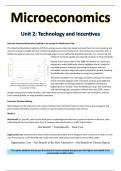Resumen
CORE-Econ - The Economy 2.0: Microeconomics - Chapter 2 Summary
- Grado
- Institución
- Book
A summary of Chapter 2 of CORE-Econ's book: The Economy 2.0:Microeconomics. The summary includes: notes on all content covered in the chapter; graphs, tables and diagrams (alongside explanations for clarity); and a bullet point summary of the chapter.
[Mostrar más]



